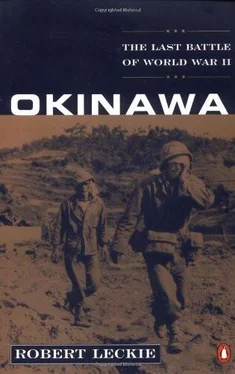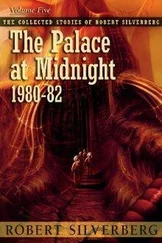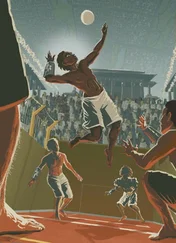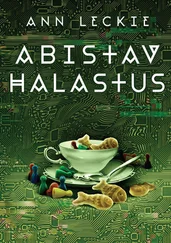Because Colonel Hara had buried his headquarters deep below the main ridge, he had complicated his communications: his only problem. Although many tunnels had interconnecting passages and there were also voice tubes, some underground positions were isolated, compelling Hara to use runners who would be exposed to enemy fire once they appeared above ground. Hara had no fear of the Americans’ plentiful and powerful tanks, so superior to the Japanese diminutive “kitchen sinks” that had been nevertheless unstoppable against inferior or lightly armed troops in the Manchuria-Burma-Philippines campaigns. Fronting Kakazu Ridge and running its entire length was a deep gorge cut into the coral by the immemorial passage of a narrow stream. The gorge was a natural antitank obstacle, impassable to tracked vehicles. For tanks to attempt to turn either flank of the ridge would bring down on them a storm of artillery.
Finally, Colonel Hara had emplaced outposts in tombs and concrete pillboxes on the ridge’s northern face. Most effective of all, he had cleverly emplaced most of his infantry and all of his mortars on the southern or reverse slope of the ridge. They were thus in untouchable defilade, shielded from enemy troops, artillery, and even American battleships. Not even enemy mortars, with that weapon’s high, looping trajectory, could reach them. Moreover, the Americans were absolutely unaware of this reverse-slope concentration; while Hara, of course, had his entire front registered by his own guns.
Thus, Kakazu Ridge.
Colonel May was sometimes called “a soldier of the old school”—meaning that he believed that the brave charge could usually carry the day. This does not suggest that he would not maneuver, only that faced by such a forbidding unflankable position, he would instinctively fall back on the frontal assault. So he ordered two of his three battalions to storm Kakazu Ridge and Kakazu West on April 9, actually expecting both to fall by the following morning. This meant that—in accordance with American infantry doctrine—a battalion of three companies would use two of them in attack with the third in reserve, and thus, two companies would strike the main ridge and two more Kakazu West, with the remaining two on call in their rear. To achieve surprise, there would be no artillery preparation beforehand, and all units would attack before daylight.
Right at the start one of the companies assaulting Kakazu West was late moving out and did not march until daylight, when it was sighted and promptly pinned down. The other company was commanded by a born fighter and leader, First Lieutenant Willard Mitchell, a powerfully built southerner who had played both football and basketball for Mississippi State. Idolized by his men and called “Captain Hoss,” he was also beloved for his un-bashful battle cry: “Watch out! Here comes ‘the Hoss’—and God is on the Hoss’s side!” Mitchell returned their affection by calling them his “Lardasses,” a fondly derisive and droll nickname that they loved.
Mitchell’s Lardasses were quick to ascend Kakazu West under cover of darkness, and not particularly dismayed to learn that they were alone on its crest and that their supporting comrades were pinned down below. They also found that the position was composed of two knolls—one on the north, and the other to the south, forming Colonel Hara’s reverse slope. Between them was a shallow saddle of land. The moment that the Japanese emerged from their steel-and-coral fortress, Mitchell quickly formed his company into a perimeter on the saddle, just deep enough to conceal a prone man. He hoped to riddle them if they charged forward to clear both saddle and northward knoll. But the enemy refused to oblige, opening fire from their own position and showering the saddle with hand grenades and satchel charges, bags stuffed with explosive. Mitchell’s men fought back with the same weapons, and a furious battle raged back and forth all morning long—with men killed and wounded on both sides.
Throughout the action, Mitchell roved the besieged saddle, hurling grenades and firing his carbine, his battle cry booming from his lips. His men were his gallant equal, and one of them —Pfc. Joseph Solch—spotted an enemy spigot mortar mounted in a cave on the reverse slope. Just one of its 320 mm shells could destroy the Americans on the saddle. With Captain Hoss, Solch and his buddies attacked the huge mortar, destroying it with hand grenades and killing its nine-man crew.
At about noon, sensing that the Americans had but a small force in front of him, Colonel Hara ordered his men to make a series of four furious counter-attacks on the enemy. So that they might surprise the Americans, and with brutal indifference to their destruction or survival, he sent them charging through his own mortar fire. Lieutenant Bill Curran killed both the leaders of the first charge, while his men repulsed the Japanese with heavy loss. When a second assault came, Solch, squatting on his haunches, fired his Browning Automatic Rifle (BAR) from the hip to repel an entire company. In the final charge, the Japanese—throwing “satchel charges as big as boxes of apples”—came within a few feet of overrunning the “American devils” but finally fell a few feet short.
Even so, Mitchell’s company was being badly whittled. Because his soldiers were lying on hard coral, they could not get below ground by scooping out foxholes, and thus were inviting targets for enemy riflemen and exposed to the flame and fragments of exploding mortar shells.
Fierce fighting also raged atop Kakazu Ridge to the east, or left of Mitchell’s position. Here the Japanese popped in and out of their barricaded caves to strike the men of companies led by Captain Jack Royster and First Lieutenant Dave Belman. They also charged up the reverse slope, again braving their own mortars. An entire American platoon was pinned down by a pair of enemy machine guns. Pfc. Edward Moskala crawled toward them, clutching his BAR. When close enough but still unobserved, he hurled grenades at the unsuspecting Japanese, rising to rush them spraying bullets. Both guns were knocked out.
Now Lieutenant Belman was hit, refusing evacuation despite great loss of blood. Captain Royster took a mortar fragment in the face. In exquisite pain and nearly blind, he also refused to leave. But it was becoming plain to both officers that the enemy was gaining the upper hand. GIs had already begun to withdraw off the ridge crest, hunting protection in the numerous caves and holes on the ridge’s northern face. After Royster radioed battalion for help, Lieutenant Colonel King ordered another company to the rescue. But this unit got no farther than the gorge, crouching with the men who had been pinned down there since sunup. King now believed that his battalion was in trouble and asked May for permission to withdraw. May refused, telling King that he’d lose as many men withdrawing as he would holding the hill. He also told him that if he was “jumpy, have the executive officer take over.” Understandably, there was no reply.
Captain Royster on the ridge had a far better appreciation of his danger than either hard-boiled Eddy May or the cautious Colonel King. His and Belman’s company could not possibly retreat in full view of the enemy. So Royster called for smoke shells from the Eighty-eighth Chemical Mortar Battalion. They went humming up and looping down, but the wind blew them back into Royster’s face. Eventually there was enough smoke to conceal a withdrawal, and the GIs began crawling down toward the gorge, many of them carrying wounded buddies with them. Ed Moskala was the last man down, but when he learned that a wounded man unable to move was still atop the ridge, he went back up to bring him safely down.
Now the remnants of King’s entire battalion were pinned down in the gorge, immobilized by enemy fire. To leap erect was to die. Second Lieutenant Leo Ford, the officer now in charge, decided that the best way out was to creep down the defile to the jump-off point of Hoss Mitchell’s company earlier in the day. Snaking along inch by inch on their bellies, dragging their wounded, Ford and his men moved westward at a snail’s pace. Ed Moskala, who had volunteered again to act as rear guard, covered their withdrawal. Twice he rescued wounded buddies, but on his second trip he paid for his gallantry with his life. For these acts of infinite compassion, and his bravery in destroying the enemy guns, Moskala received the posthumous award of the Medal of Honor.
Читать дальше










